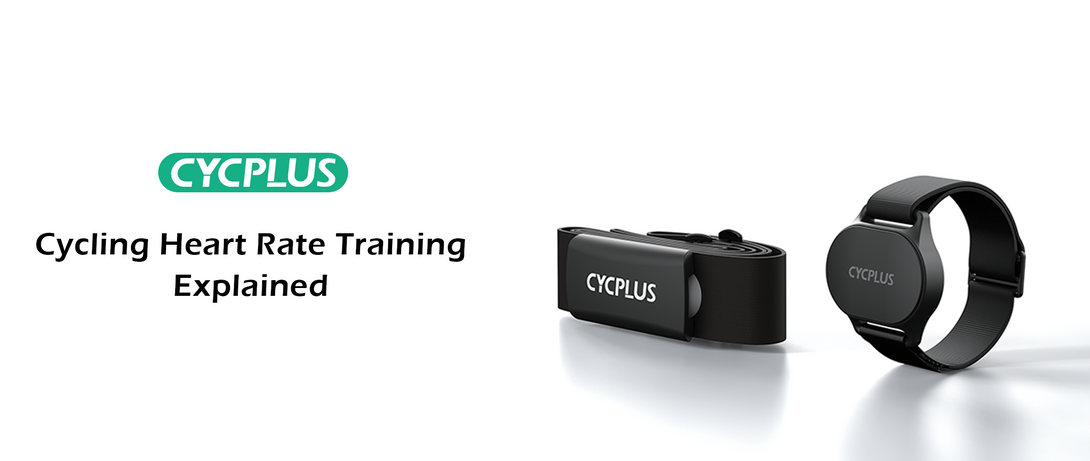Cycling Heart Rate Training Zones Explained
(and How to Use Them with CYCPLUS H1 & H2)
June 23, 2025

In professional cycling training, heart rate monitoring is a cornerstone. Unlike power meters, which measure external output, heart rate reveals the internal cost of effort—how the body responds to training stress. From cardiovascular load to energy metabolism, heart rate data provides a real-time window into adaptation and recovery.
In short, heart rate is the body’s “native language.” Learning to interpret it helps riders train smarter, avoid overtraining, and achieve peak performance.
1. Why Heart Rate Zones Matter
Heart rate is linearly correlated with oxygen uptake (VO₂), making it one of the most reliable indicators of exercise intensity. Its scientific value is grounded in three physiological pillars:
1. Energy Metabolism
- Z1–Z2: Fat is the primary fuel (enhances mitochondrial density).
- Z3+: Glycogen dominates (>80%), requiring careful time management.
2. Neuromuscular Adaptation
- Z2: Strengthens slow-twitch (Type I) fibers → endurance.
- Z4–Z5: Recruits fast-twitch (Type II) fibers → power and speed.
3. Cardiovascular Load
- Each +10 bpm increases cardiac output by ~6–8%.
- Z3 is an optimal zone for capillary growth, mitochondrial synthesis, and lactate buffering.
2. Five Heart Rate Training Zones

Common Mistakes:
- Mixing Z2 with Z3 → reduces fat-adaptation benefits.
- Staying in Z3 >60 min → elevated cortisol, prolonged recovery.
Pro Tip:
Pair heart rate with power data for dual control. For example, Efficiency Factor (EF = Power ÷ HR)—if EF drops, it’s a sign aerobic efficiency is declining and more Z2 work is needed.
3. Periodized Training Models
1. Base Phase (8 weeks):
Z2 70% + Z1 30% → build aerobic capacity.
2. Pre-Race Phase (6 weeks):
Z3/Z4 50% + Z2 40% + Z5 10% → raise thresholds.
3. Race Phase:
Z4/Z5 intervals → activate race readiness.
4. Recovery Week:
Z1 >80% → reduce metabolic stress.
Examples by Race Type:
- Gran Fondo (100 km endurance): More Z2 foundation, steady Z3/Z4 closer to event.
- Criterium/Short Races: Focus on Z4 intervals (4×5 min at 95% HRmax) and Z5 sprints (10×15 sec).
Pro Tip:
Insert a reduced-load week every 3 weeks (–40% volume, maintain intensity) to prevent plateau.
4. Monitoring & Adjustment
- Cardiac Drift: In hot weather, HR may rise 10 bpm at Zone 2 → reduce power output by ~15%.
- Morning HR: If resting HR is +8 bpm above baseline for 3 consecutive days → enforce recovery.
- Efficiency Factor: A 10% drop at Z2 intensity → schedule rest before resuming hard sessions.
5. Training Tools & Integration
Heart Rate + Power Dual Check
Aim for <5% power fluctuation and <3 bpm HR variation in Zone 4 work.
HRV (Heart Rate Variability)
Morning HRV <70 ms → postpone high-intensity workouts.
TSS (Training Stress Score)
Weekly TSS >700 = risk of overtraining (pro riders may reach ~1200).
6. Execution Rules
Z2: Strict control within ±3 bpm.
For every 1 hour of Z4 training, allow ~24 hours of recovery.
Every 12 weeks, take 1 full recovery week (only Z1).
Key Insight:
The difference between elite athletes is not in Z5 sprints—it’s in their Z2 efficiency (watts per bpm).
7. CYCPLUS H1 & H2 Heart Rate Monitors
CYCPLUS H1 Arm Band HR Monitor
Technology: Optical sensor measures blood flow via light absorption, converting it into digital HR data.
Features:
- 110+ hours battery life
- Lightweight 13 g design
- Magnetic fast charging
- Dual ANT+ & Bluetooth connections
CYCPLUS H2 Chest Strap HR Monitor
Technology: ECG-based sensor extracts HR data from heart waveforms, with proprietary algorithms to reduce motion artifacts and interference.
Features:
- ~500 hours battery life
- Skin-friendly, anti-slip design
- Comfortable fit and accurate real-time HR monitoring
Device Compatibility
Apps & Platforms: Zwift, Strava, Wahoo, TrainingPeaks, Polar Beat, and other Bluetooth-compatible apps.
Devices: Garmin, Wahoo, Bryton, CYCPLUS, and any ANT+ HR-compatible bike computers or watches.
Conclusion
Heart rate training is about more than numbers—it’s about listening to the body. By combining structured zones, periodization, and tools like the CYCPLUS H1 and H2, cyclists can balance training load, avoid overtraining, and maximize performance.
“Power shows what you produce. Heart rate reveals what it costs.”


